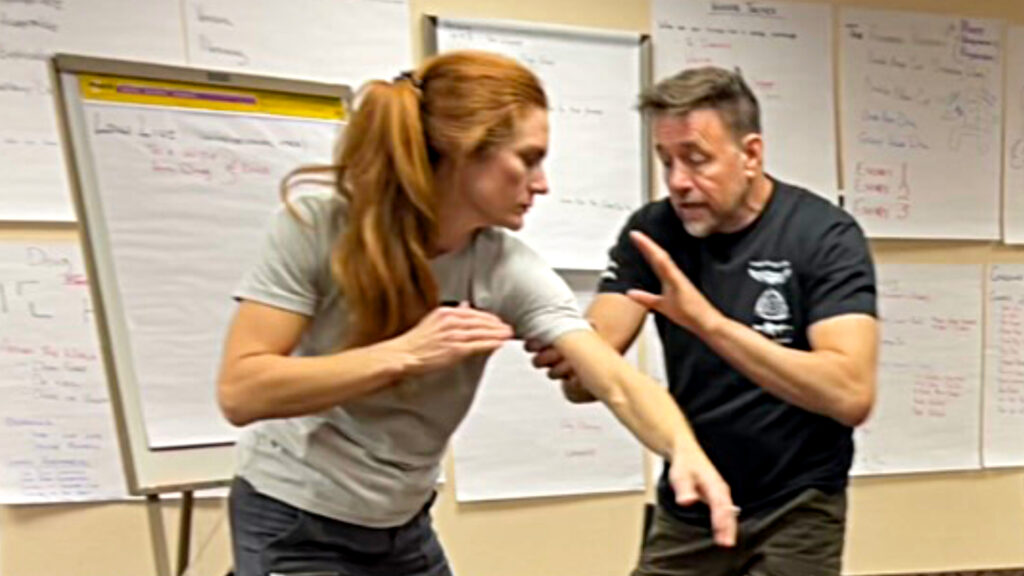
Have you ever dedicated yourself to mastering a new skill, practicing it tirelessly until it felt like second nature, ingrained in your body and reflexes? You emerge from this rigorous training confident that you’ve acquired this new ability. But then, you find yourself attempting to execute this skill under the duress of heightened physical and or mental stress. Were you taken aback when, under this intense pressure, your newfound proficiency began to unravel, or perhaps even morphed into a completely different behavior that bore no resemblance to what you had so diligently practiced? This phenomenon can be a humbling reminder of how our skills are tested and often reshaped in the crucible of stress and real-world application.
Environmental Training
Within the C-Tac system, the practice of honing skills under varying degrees of resistance and stress, known as Environmental Training, is a critical component of the learning curve. This advanced stage of training is essential in solidifying your understanding of a technique. After you’ve learned a technique and drilled it until it feels automatic—embedded deep within your nervous system—the next phase is to test it across diverse environmental conditions.
These controlled training scenarios are pivotal in revealing just how deeply your responses have been etched into your nervous system. Mastery at a low level of resistance and stress does not guarantee the same proficiency under moderate or intense pressure. The design of these environmental training sessions is strategic, akin to having a volume knob that can incrementally intensify stress levels. This “volume knob” should allow you to dial up the pressure to the edge of your skill’s breaking point without surpassing it, thereby preventing the collapse of the technique or skill you are working on.
Over time, this carefully modulated stress exposure allows the skill to be refined and strengthened, enabling it to withstand and function effectively under high-stress and chaotic situations. Consider environmental training as both a crucible and a cultivation ground—a laboratory where you can rigorously test and intelligently enhance your body’s responses. Ultimately, it prepares you to maintain composure and proficiency amidst the turbulence of real-world confrontations and high-resistance encounters.
The “Faster And Harder” Misconception
In many cases, the application of resistance training lacks a strategic approach. It’s a common misconception that simply pushing yourself to move “faster and harder” will lead to improvement, but this isn’t always the case. Without a gradual and intelligent build-up to withstand high stress, a “faster and harder” regimen can actually reinforce poor habits. While such training might yield physical toughness and a robust workout, being fit and tough are not everlasting attributes; they wane with age.
As physical prowess declines, students or practitioners often become disillusioned, leading to their eventual withdrawal from training—a scenario I usually describe as the “good old days” effect.
There are those who rely solely on their strength and speed for self-defense training. When these attributes inevitably diminish, they become the ones who sit on the sidelines, reminiscing about their peak days in the past.
This is why it’s crucial to adopt an intelligent training methodology that focuses on timeless principles. Techniques and skills should be developed based on principles that remain effective regardless of age or physical changes. This approach ensures a sustainable self-defense practice that remains reliable over a lifetime, not just during the zenith of physical youth and vigor.
After experiencing a high-stress situation and identifying behaviors that might hinder your success, the question arises: how do you rectify these issues?
Drilling (Nerve Training)
In the Martial Arts world, certain drills across various styles have been criticized and misunderstood. Critics often observe these drills, pointing out that the choreographed sequences do not accurately reflect real combat situations. They judge these exercises as if they were direct representations of a fight, and based on this flawed perspective, they might dismiss the value of the drill or the practice of drilling itself. What is missed in this critique is the fundamental purpose of these drills: they are not meant to mimic a fight in its entirety.
While there is some overlap with actual fighting techniques, drills are primarily designed for high-frequency repetition of specific movements. Repetition is indeed key to mastering any skill, as it embeds reactions or movements into the nervous system, making them automatic. This is often achieved through a series of repetitions performed with a specific tempo, which reinforces the skill and facilitates its integration into muscle memory. This is particularly evident in the rhythmical patterns found in Filipino Martial Arts drills.
It’s essential to recognize that not all drills may instill the movements you need or agree with, and that’s perfectly fine. The value lies in the drilling methodology itself. Once you understand the mechanism behind drills, you can craft personalized exercises tailored to correct specific mistakes identified in high-stress scenarios.
By developing and repeating these customized drills, set to a certain rhythm and tempo, you can transform bad habits into effective responses within a resistant environment.
After this rigorous practice, when the desired response becomes natural in training, the original drill might become redundant. At that point, you can either set it aside or innovate a new one to address another area of improvement. This highlights the importance of grasping the concept of drilling rather than clinging to the traditional drills you’ve been taught. Understand the purpose and method behind the drill, and you unlock the potential to evolve and refine your Martial Arts practice continuously.
The Timeless Tool Of Placement
A fundamental principle in martial arts and self-defense is being in the optimal position at the precise moment, such as having your hands correctly placed during a confrontation. This advantage is a key outcome of specialized drill training, where you learn to instinctively position your hands and body effectively within a combative sequence. The essence of well-structured drills is cultivating these automatic placements; when executed properly, these exercises condition your body to naturally assume the right position at the right time. Often, simply being in the correct position can significantly improve the outcome of a physical altercation with a potential threat. The goal of these drills is to engrain such movements and positions into your muscle memory, allowing you to react correctly and efficiently without conscious thought during high-pressure situations.
High-Percentage Techniques
The time you’re prepared to dedicate to training will directly influence how deeply you can delve into this educational process. If your training time is scarce, it’s crucial to selectively focus on high-percentage techniques and applications within the drills mentioned earlier. High-percentage techniques consistently prove effective across a broad range of individuals; they are often the foundational movements taught in various self-defense and martial arts courses. Unfortunately, not all instructors or martial arts disciplines will highlight these essential techniques, necessitating an unfiltered examination of everything you learn. Given the limited training time, it’s vital to prioritize methods and concepts that yield tangible results, avoiding the investment of time and effort in less effective practices. The techniques you choose should not only be practical but also resonate with common sense, ensuring that they integrate seamlessly into your nervous system for effective application in real situations.
The Map: Navigating Your Training Path
The journey to mastering any skill, especially in the realm of martial arts or self-defense, can be visualized as navigating a map comprising four essential landmarks: Techniques, Environment, Drills, and Repeat.
Techniques
The foundation of any martial arts or self-defense training program lies in its techniques. These are the building blocks, the specific movements, and strategies that you will rely on in a confrontational situation. Learning these techniques is the first step in your training journey. It involves understanding each movement or strategy’s mechanics, purpose, and application to ensure a solid base upon which to build your skills.
Environment
After mastering the fundamental techniques, the subsequent phase involves applying them against resistance, typically with a training partner. As previously discussed, it’s important to have control over the resistance level or pace of training, gradually escalating to a comprehensive physical engagement. Familiar activities like rolling in Brazilian Jiu-Jitsu, sparring in Thai Boxing, or engaging in hand fighting and pummeling serve as examples of this progression.
In the C-Tac system, we strive to create training scenarios reflective of the Combat Blueprint, which aims to systematically increase resistance across various combat dimensions. This includes training with firearms, edged and blunt weapons, as well as enhancing skills in striking, pummeling, and exploring the five distinct realms of ground combat. The goal is to cultivate a robust and adaptable skill set that can withstand the pressures of realistic confrontation scenarios.
Drills
Drills are the practice exercises that bridge the gap between isolated techniques and their application in dynamic situations. They provide the repetitive action necessary to ingrain each movement into nervous system memory. Drills can vary in complexity and intensity, often designed to simulate the stress and unpredictability of an actual confrontation. Through continuous practice, drills reinforce the automatic execution of techniques, making them second nature.
Repeat
The final landmark on the map is repetition. Mastery is not achieved through a one-time effort but through consistent and deliberate practice. Repeating techniques, drills, and environmental adaptations reinforce learning and embed the skills deeply into your psyche and physical responses. This cycle of learning, practicing, and repeating ensures that your abilities are honed to the point where they can be executed efficiently and effectively under pressure.
In conclusion, navigating the map of your training journey requires a balanced approach that includes learning the proper techniques, applying them in varied environments, drilling them to perfection, and committing to continuous repetition. This cyclical process forms the core of effective martial arts and self-defense training, paving the way to true mastery and confidence in your skills.
This entire training philosophy is borrowed from the C-Tac system If you would like more information on C-Tac you can find it on the website HERE. Additionally, you can contact us directly at any time, and we will give you more information.
Shift Your Perspective, Take the Action, Transform Your World.
~ Sifu Alan
Join Our Email List HERE

Alan Baker is celebrated for his exceptional skill in creating customized Defensive Tactics Programs and his prowess in high-performance coaching. Tailoring his expertise to meet the needs of law enforcement agencies, military groups, and security companies, Alan crafts training curriculums that are grounded in practical techniques, adaptability to real-life scenarios, and intensive, situation-specific exercises. His training methodologies are meticulously designed to elevate the operational effectiveness and situational preparedness of individuals in high-stakes environments. Learn more about Alan’s distinctive programs here.
Beyond his tactical acumen, Alan is also a foremost “mindset” coach, adept at tapping into the untapped potential within individuals. He is particularly attuned to the current societal trend that often overlooks traditional masculinity and the cultivation of strength. Addressing this, Alan champions the development of a warrior spirit — the readiness to confront chaos and take decisive action when necessary. He passionately mentors professionals, entrepreneurs, and individuals on their personal development journeys, focusing on fostering a mindset dedicated to excellence. His coaching is anchored in pragmatic strategies that fortify mental resilience, enhance focus, and stimulate drive. Engaging with Alan sets you on a transformative journey where mental obstacles are overcome, innate strengths are recognized and honed, and your objectives become distinctly attainable. His insights are key in boosting performance and developing a mindset geared for victorious accomplishments.
For a deeper exploration of Alan’s mindset philosophy and his approach to empowering especially men to embrace their strength and resilience, delve into his insightful collection of books. If you’re ready to accelerate your personal and professional growth under Alan’s expert guidance, connect through his official website.

